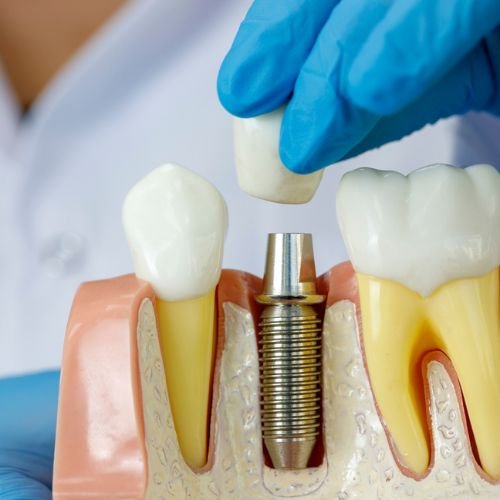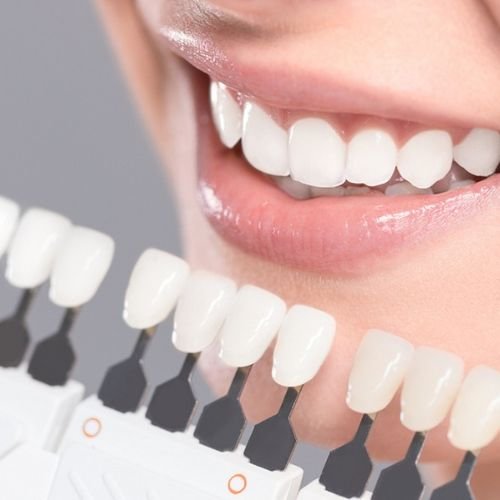Dental veneers are a popular cosmetic dentistry option to achieve beautiful teeth. There are different types of dental veneers, each with its advantages and disadvantages.
This blog post will discuss different dental veneers and their uses. We’ll also discuss the costs and benefits of each type of veneer. So if you’re considering getting dental veneers, be sure to read this post!
What Are Dental Veneers?
Dentists use dental veneers to enhance the appearance of the teeth. Veneers are made of thin shells of ceramic or porcelain bonded to the front surface of the teeth.
Veneers can be used to address several dental problems, such as gaps between teeth, misshapen teeth, damaged teeth, and discoloured teeth. It is a cosmetic and restorative dental procedure that gives teeth a brighter and more uniform appearance.
Veneers are custom-made for each patient. They are made to give patients natural-looking, beautiful teeth. The placement of dental veneers is painless and easy. Your dentist can do it in as little as two dental visits.
Dental veneer placement is a cosmetic procedure which means it requires proper maintenance. Once your veneers are in place, you will need to take good care of them, just like your natural teeth, practising good dental hygiene with regular brushing and flossing to prevent tooth decay. Veneers can last many years if they are well cared for.
Common Types Of Dental Veneers

There are three types of dental veneers commonly used today: porcelain, composite, and temporary.
Porcelain Veneers
Also called ceramic veneers, this type of veneer is made from thin sheets of ceramic material cut to fit over the front surface of the teeth. They are designed to be stain-resistant and have a natural appearance, making them a popular choice for people who want to improve their smiles.
Composite Veneers
Composite veneers are thin sheets of resin material bonded to the teeth. It is less expensive than porcelain veneers but not as durable. Composite veneers also discolour over time and may require more upkeep. Like porcelain veneers, its placement may take a minimum of two dental visits.
Temporary Veneers
Temporary veneers also called removable veneers or non-permanent veneers, are made from a plastic material placed over the teeth. They are less expensive than porcelain or composite veneers, but they are not as durable and may need to be replaced more often. These veneers are more commonly used as interim veneers, while the porcelain and composite veneers are fabricated in the laboratory.
Ultimately, the type of veneer right for you will depend on your budget and personal aesthetic goals.
The Pros And Cons Of The Different Types Of Veneers
If you are considering getting veneers, it is important to weigh the advantages and disadvantages before deciding. The tables below give you a quick look at the pros and cons of each type of veneer.
Porcelain
| Pros | Cons |
| Blend with natural tooth colour | Lengthy procedure |
| Resistant to stains | Expensive |
| Durable | Invasive procedure |
| Lower chances of breakage & fracture | May cause tooth sensitivity |
| Smoother, tooth-like texture | Needs tooth reduction |
| Doesn’t harm surrounding teeth & gums | |
| Typically lasts 10-15 years | |
| Little plaque build-up with proper oral care |
Composite
| Pros | Cons |
| Less invasive | Easily stains over time |
| Requires little enamel removal | Less durable than porcelain veneers |
| Less chance of harming gum tissue | Doesn’t last as long as porcelain |
| Easily repaired if broken & chipped | May cause tooth sensitivity |
| Lasts 5-7 years | |
| A more affordable option than porcelain veneers |
Temporary or Snap-On Veneers
| Pros | Cons |
| Convenient | Do not look as natural |
| Less expensive | More prone to plaque build-up |
| Provide instant results | May harm gum tissue |
| Not a long-term dental solution |
How To Choose The Veneers For You

When choosing veneers, there are a few things you need to keep in mind.
Cost
Veneers can be expensive, so you should ensure you receive the best value for your money. If you’re willing to shell out money for long-lasting, more naturally-looking veneers, you may choose to have porcelain veneers. If you are looking for a more economical choice, composite veneers may be a better fit. It is less expensive than porcelain veneers, and they can be easier to repair when they become damaged.
Material
There are different types of veneer materials to choose from, each with its pros and cons. Porcelain is an excellent choice for veneers, as it is strong and durable. However, the composite veneers are less expensive. It is not as strong as porcelain veneers, but they are easier to repair if they become damaged.
Purpose
The type of veneer material you choose should also be based on the purpose of your veneer. There are different types of veneer materials that you can choose from depending on your needs. Porcelain and composite veneers are best for long-term use because they are more durable. If you want to use veneers for a special occasion only, then you may use temporary veneers. If you want it to be used for aesthetic purposes only, you can choose any veneer. But if you also want it to be functional, you may choose porcelain or composite veneers.
Take the first steps toward your perfect smile today!
Or Call Us : (08) 6495 4004
Do Snap-On Veneers Work?
Snap-on veneer is an alternative to traditional dental veneers. They are made from custom-crafted resin to fit over your existing teeth and can be removed and replaced as needed. They’re not bonded to the tooth.
These temporary veneers are affordable and convenient for many people who want to improve their smiles instantly. They are an ideal solution for those who want to improve their smile without breaking the bank.
Snap-on veneers are easily snapped on the teeth and can be removed and reapplied as needed. Due to the strength of the resin material used, snap-on veneers can last for two to five years. However, this may still vary depending on use and care. Proper placement and removal and proper diet are needed to ensure that Snap-on veneers can last long.
Snap-on veneers can be an effective way to cover up stained, chipped, or misshapen teeth. They can also close gaps between teeth or change your smile’s overall shape. If you are considering Snap-on veneers, it is important to consult with a qualified dental professional to see if they are right for you.
Estimated Cost Of Dental Veneers
It isn’t easy to estimate the cost of dental veneers without knowing more about the specific case. However, patients can expect to spend anywhere from $400 to $1,500 per tooth for their veneers.
The estimated cost of dental veneers can vary depending on several factors. The table below will show you the estimated cost of each type of veneer.
| Type Of Veneer | Average Cost |
| Porcelain | $1,050 per tooth |
| Composite | $375 per tooth |
| Snap-On | Between $500-$2,000 for a complete set |
Factors that affect the cost of dental veneers include:
Choice Of Material Used
Dental veneers are made from either porcelain or composite material. Porcelain veneers tend to be more expensive than composite veneers, offering a more natural look.
Number Of Veneers Needed
The number of veneers needed will also affect the overall cost. For example, a patient who needs only four veneers will likely pay less than one who needs eight or more.
Geographic Location
Finally, where the procedure is performed can also affect the price. Dental procedures tend to be more expensive in big cities than smaller towns.
What Type Of Veneers Can Last Longer On The Teeth?

Both porcelain and composite veneers are considered to be very durable and can last for many years with proper care. However, porcelain veneers are considered to be the more durable option.
Porcelain veneers are less likely to stain or chip than composite veneers and can resist wear and tear better over time. As a result, porcelain veneers are typically the preferred choice for patients who want their veneers to last as long as possible.
What’s The Difference Between Composite Bonding And Composite Veneers?
Composite bonding and composite veneers are two popular options for repairing damage to the teeth or improving the smile’s appearance. But what is the difference between these two procedures?
Composite bonding involves using a tooth-coloured resin to repair small chips, cracks, or gaps in the teeth. The resin is applied directly on the tooth inside the patient’s mouth, shaped and contoured depending on the desired appearance and then hardened with a special light. Composite bonding can be completed in one office visit.
Composite veneers are thin shells of tooth-coloured material fabricated and designed using the patient’s tooth model. Like composite bonding, composite veneers are bonded to the front surface of the teeth, and they can be used to cover up chips, cracks, or gaps. It can also change the teeth’s shape, size, or colour. Composite veneers require tooth reduction before placement, and it takes a minimum of two office visits to complete since some laboratory work is required.
Are There Alternatives To Dental Veneers?

While dental veneers are a popular choice for many people looking to improve the appearance of their teeth, they are not the only option available. If you are considering veneers, it is worth exploring all of your options to make the best decision for your needs.
Some alternative restorations to dental veneers include:
- Dental Crowns: Dental crowns are often used to restore damaged or decayed teeth. However, they can also be used for cosmetic purposes. Crowns can be made from porcelain or composite material and can be colour-matched to your natural teeth.
- Dental Implants: Implants are a more permanent and long-term dental solution to replace missing teeth.
- Dental Bonding: Dental bonding is a less invasive and less expensive alternative to veneers for broken and chipped teeth. With dental bonding, the resin is applied to the tooth surface and then hardened with a light. The resin can be shaped and polished to match the surrounding teeth.
- Tooth Reshaping: This involves removing some of the natural tooth enamel to change its shape. It can correct slightly crooked, misaligned teeth or make them look longer or shorter. It is also less expensive than veneers and can usually be done in one office visit.
- Teeth Whitening: Teeth whitening is another popular way to improve the appearance of your natural smile. There are several ways to address tooth discolouration, including at-home kits, professional dental treatment, and over-the-counter whitening products.
Ask your dentist about various treatment options that are available for you. You can explore alternative treatment plans with your dentist during the treatment planning stage.
Final Thoughts
If you’re looking for a new and more beautiful smile, veneers may be the perfect option. There are many different types of veneers available today, so it’s important to research before choosing the right ones for your needs.
At South Lake Smiles, we offer various veneer options that will suit any budget and lifestyle. We also provide our patients with online booking, making scheduling an appointment easy and convenient.
Talk to an experienced dentist from South Lake Smiles today. If you have any qu







